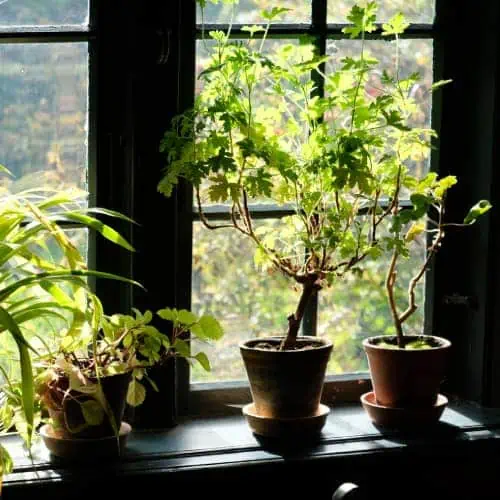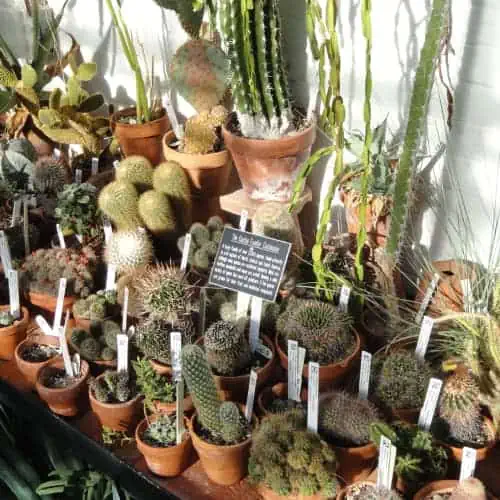
Radiation, which may come in the form of electromagnetic waves, is generated by a multitude of commonplace electrical devices all around us. In the home, sources of radiation include televisions, mobile phones, computer screens, and even hair dryers. Outdoors, radioactive waves are emitted by the sun, power lines, broadcast towers, and signal transmitters. At high levels, these waves can potentially harm life by increasing the risk of cancer-linked mutations.
One way to reduce EMF (electric and magnetic field) radiation levels around and within your home is by growing plants. Radioactive materials are taken up by plants through three means: (1) deposition, through which radiation moves through the surfaces of the leaves and into the plant, (2) translocation, which involves the local transport of radiation within plant tissues, and (3) root absorption from the substrate.
An Important Note About Plants & EMF
There are very few studies that actually emphasize the EMF-absorption capacity of popular indoor plants. Note that ALL plants can absorb, take up, or convert at least one form of radiation, but they are rarely (if ever) efficient enough to remove all radioactive materials from the air or soil. In the face of gamma rays and EMFs, they are not a replacement for government-approved radiation blockers. The best way to eliminate harmful radiation from your home is still to fully remove the source.
Fortunately, studies that have looked into the radioactive effects of common household devices have yet to show that these emit a strong enough electromagnetic field to actually cause significant harm. Plants would therefore be more beneficial as filters of other toxic pollutants.
Nevertheless, if you feel that you can’t be too cautious, growing indoor plants is a great way to combat many types of radiation. Garden plants and outdoor crops can also help by reducing radiation levels in the ground itself. These photosynthetic species can help purify the air of many toxins, so it’s great to have them in practically every room of the house and every corner of the garden!
1) Common sunflower (Helianthus annuus)

UV-B, the type of solar radiation that is known for causing sunburn, can quickly be converted by the common sunflower into ecologically beneficial plant features. It is also able to take up more harmful radioactive materials in the air and substrate by sequestering these in its leaves and stems. For this reason, sunflowers are often planted around sites with known nuclear contamination.
As a “phytoremediative” plant, sunflowers are hyperaccumulators with the capacity to absorb toxic elements (e.g. heavy metals like cesium and strontium, which are present in high concentrations in soils at the site of nuclear disasters like Chornobyl and Fukushima). Sunflowers rapidly concentrate these elements in the shoot, where they may be converted into carbon-based compounds. Once the plant has absorbed these toxins, the plant’s tissues and its byproducts can be quite dangerous for animals to consume.
Though sunflowers that have absorbed radiation are not safe for use as a source of essential oils and seeds, they can be used to produce biofuel for energy. Of course, it must also be said that, though they are effective at absorbing harmful toxins in nuclear sites, they won’t necessarily serve as effective radiation screens in the home itself. Even so, cultivating a few of these is encouraged because of their overall ecological benefits!
2) Mustard greens (Brassica juncea)

With cultivars that are used all around the globe as a source of oils, seeds, and edible leaves, B. juncea is now widely grown as a crop. Its dense and flowering stands make for bright yellow tufts, which tend to cover rolling hills in regions that grow them extensively.
Mustard greens have shown potential as a phytoremediative plant in areas that are heavily contaminated with dangerous radioactive compounds. Like sunflowers, it can hyperaccumulate toxic elements (i.e. heavy metals like lead and cesium) and compounds that have become bound to substrates. It can be cultivated to “absorb” these radioactive materials as a means to cleanse the soil before it is planted with crops for human consumption.
Exposure to gamma radiation has been shown to cause mutations in some cultivars of B. juncea. This shows that, in a laboratory setting, the plant is able to absorb enough radiation to significantly alter its genetic code. This goes to show that many of the plants listed here may be invisibly affected, despite their tolerance for heavy metals and pollutants, by the radiation levels they are exposed to.
3) Aloe vera (Aloe vera)

A plant with enormous potential as a source of beneficial phytochemicals, the humble aloe vera is truly a gift from nature. Its rich history has led to its extensive use as a medicinal and ornamental plant. Thus, it is now naturalized in many tropical to subtropical countries. With succulent leaves that can be easily harvested and mashed into a vital ingredient for skincare and juices, this fleshy plant is better known for its topical uses than for its effectiveness as an air purifier.
Though there has yet to be a study that highlights the anti-radiation capacity of aloe vera, it is now widely accepted as a topical treatment for the side effects of radiation therapy. To be effective as a radiation screen in the home, however, it must be placed directly in front of the source of radiation. Note that, while its leaves are unlikely to absorb all of the potentially harmful electromagnetic waves, they should be able to help strip the air of other toxins.
A small aloe vera plant is unlikely to be effective against radiation or pollutants. If you wish to maximize the benefits of this species, do note that it will have to be grown in large densities. It would be better used as a colony-producing border plant for desert gardens that may have once been a sink for harmful types of radiation.
4) Betel leaf plant (Piper betle)

There aren’t many studies of the betel leaf plant directly combating or absorbing electromagnetic radiation. It must be noted, though, that its leaf extract has shown potential as a “radioprotective” substance against gamma and ionizing radiation. The extract also has antioxidant properties, signifying its potential as a source of pharmacologically important phytochemicals.
With a reputation as an organic drug throughout its native range, this species has a rich history. Many Southeast Asian cultures make use of betel nut as an all-around cure for something as common as bad breath to diseases as serious as lung problems. Referred to as ‘paan’ throughout India, millions of indigenous people consume this plant on a daily basis. It is even traditionally used to fight anxiety as it is said to induce a sense of well-being.
The betel leaf plant can be grown, in indoor or outdoor locations, from cuttings. If you are located in a temperate zone, it may be better to grow this tropical species in a protected area with controlled heating. Set apart by its heart-shaped leaves, it can quickly spread as a trailing plant.
5) Snake plant (Dracaena trifasciata)

Synonymous with Sansevieria trifasciata, the snake plant is one of the hardiest tropical perennials to have in your home. This phenomenal species may be even more challenging to kill than to keep alive. With roots that thrive in dry substrates and leaves that are resistant to most pests and diseases, it’s the perfect indoor plant. Those who are new to gardening will revel in this species’ ease of care and propagation.
Apart from being a living sculptural addition to your home, the snake plant provides a wealth of ecological benefits. As its bundles of leaves add color and texture, they also help filter out toxins in the air and absorb radioactive materials in the soil. As a “botanical biofilter”, it can supposedly absorb low-frequency EMF emissions from computers and wi-fi devices. Unfortunately, there has yet to be definitive proof of this.
Snake plants come in a wide range of cultivars. Some grow to several feet tall and can be used to create natural fences in the garden. Others, called dwarf snake plants, remain infinitely small. The latter is frequently used to top desks in homes and office spaces, especially as they can survive in low-light levels. Note that having one can help detoxify your space, but it won’t act as a fool-proof shield against radiation.
6) Cacti (Cactaceae)

All plants can technically absorb radiation, and cacti are no exception. Several researchers have looked into the effectiveness of several types of cacti as a natural means of blocking EMFs. For cacti to work as an effective radiation screen, they need to be oriented in such a way that they can effectively block out the line of light from a computer or phone. While they can passively absorb longwave radiation, they must be placed directly in front of the source to be effective. Basically, it would have to block out the light from your computer to actually work.
That being said, cacti make great indoor and outdoor plants in regions with arid conditions throughout the year. They come in dozens of hardy species with varied shoot forms, specialized spines, and growth orientations. Some can be maintained as fully upright and tall plants to form the backdrop or centerpieces in a desert garden. Others can be cultivated as miniature plants for the home.
The best way to maximize the electromagnetic absorption rates of cacti is by ensuring they are healthy, have room to grow, and are exposed to enough light and nutrients to produce flowers and fruits. As their shoots are filled with pores through which pollutants and radioactive waves may move into the plant, a greater surface area and a more expansive root system are desirable.
7) Spider plant (Chlorophytum comosum)

Frequently cultivated as a hanging plant, C. comosum is known for its resilience, capacity to self-propagate, and low-maintenance needs. An evergreen perennial, it comes in many ornamental forms. The most popular types have variegated and eye-catching leaves with white stripes running along their center or margins.
Due to this species’ ability to filter out many toxins in the home environment, it is generally believed to aid in reducing radiation levels as well. To maximize its potential as a radiation screen, allow the plant to mature into a large specimen in a hanging basket. It should help redirect or absorb ionizing and electromagnetic radiation if its leaves are allowed to block out the source. Note that it may not significantly reduce the coverage of your electronics’ magnetic field.
Spider plants are unique in that they produce inflorescences which eventually develop plantlets. Once these plantlets come into contact with the appropriate substrate, they can quickly become established by producing a network of adventitious roots. You’ll often see these plantlets cascading toward the ground like fireworks frozen in the air.
8) Areca palm (Dypsis lutescens)

Perfect for indoor locations and for use as an outdoor, ornamental plant, the areca palm can be cultivated as a miniature tree. It is distinguished by its arching fronds, which are borne on multiple stems extending from the rootstock of the plant. Due to the elegant and wing-like arch of its central leaf stalks, this species is also referred to as the “butterfly palm”.
A recipient of the RHS Award of Garden Merit, the areca palm can filter out a considerable amount of toxins from the air. It is not specifically known for its anti-radiation activity, but the large surface area provided by its leaflets suggests its potential as a radiation screen. It would, of course, serve best as an absorber of ionizing radiation from the sun’s rays. For best results, place this tree in front of the most brightly lit windows of your home.
In terms of structure and color, the areca palm is hard to match. Its vivid green leaves can brighten up just about any space. Its natural benefits can be maximized further outdoors, where birds can feed on its red fruits.
9) Fiddle-leaf fig (Ficus lyrata)

Extremely in demand as an ornamental indoor plant, the fiddle-leaf fig is both the bane and pride of many experienced horticulturists. A member of the mulberry family (Moraceae), it is known for being quite tricky to maintain, especially if you wish for the oldest leaves to remain in pristine condition throughout the life of the plant. Able to grow to 15 meters (50 feet) tall in optimal conditions, it is a tropical tree with spectacular features.
The fiddle-leaf fig is well-loved because of its glabrous, lyre-shaped leaves. Their crinkled edges pleasantly contrast the balanced structure of the whole plant. The leaves occur alternately along an upright shoot, which has a reputation for lengthening very slowly. It takes time and commitment to cultivate this beneficial species.
The large surface area of F. lyrata leaves makes them ideal for absorbing indoor radiation and pollutants. The leaves should ideally help block out (but not totally eliminate) radiation when they are situated in the right place. Note, however, that this tree is toxic and should not be placed in rooms that are easily accessed by children or pets.
10) English ivy (Hedera helix)

A plant with a knack for thriving without any assistance, the English ivy is an evergreen vine with endless potential. This hardy plant can grow just about anywhere, as long as there are shallow cracks and crevices where its roots can gain footing. As an indoor plant, it can be cultivated in shallow pots or hanging baskets, from which its trailing shoots can gracefully cascade.
Outdoors, English ivy can be grown along trellises and natural-roofed pathways, where the shoots and leaves can form a sun screen. This species is remarkably effective at absorbing UV radiation. Its nanoparticles can apparently be used as an ingredient in organic sunscreens which may outperform metal-based ones.
Easy to cultivate, propagate, and maintain, English ivy is set apart by its palmate leaves. These differ in color and variegation according to cultivar, many of which are recipients of the RHS Award of Garden Merit. If sunlight blasts too harshly through your windows, consider installing a few hanging pots of English ivy. Their generous sprays of leaves should provide you with just the right amount of dappled, indoor shade.
11) Asparagus fern (Asparagus setaceus)

Contrary to what its common name suggests, A. setaceus is not actually a true fern. It is simply referred to as one because of the fern-like structure of its fronds. Its species epithet alludes to the hairy appearance of its soft and fine leaflets. With sturdy, green shoots that can grow to several meters long, this perennial is often placed in indoor locations that could use color and texture. Apart from increasing the aesthetic appeal of its surroundings, it provides many ecological benefits.
When placed close to potential sources of electromagnetic radiation, this species’ foliage can supposedly absorb non-ionizing radioactive waves. While it definitely wouldn’t reduce the impact of something as serious as nuclear fallout, it should at least help minimize the spread of radiation emitted (though in arguably harmless amounts) by household electronic devices.
Though it can withstand exposure to electromagnetic radiation, this plant may scorch under strong ionizing radiation from the sun. Situate it in an area of the home or garden with dappled or partial sunlight.

